 The Phase Change Matters e-mail newsletter is a weekly summary of the latest news and research on phase change materials and thermal energy storage. To subscribe, visit www.puretemp.com/subscribe. For more frequent updates, follow @puretemp on Twitter or visit the Phase Change Matters blog, www.puretemp.com/pcmatters.
The Phase Change Matters e-mail newsletter is a weekly summary of the latest news and research on phase change materials and thermal energy storage. To subscribe, visit www.puretemp.com/subscribe. For more frequent updates, follow @puretemp on Twitter or visit the Phase Change Matters blog, www.puretemp.com/pcmatters.
BUILDING | CONSTRUCTION
Biobased PCM is put to the test at new high school in Arizona
A pilot study is underway to gauge the effectiveness of phase change material to reduce and shift HVAC load at a new high school outside Phoenix, Ariz.
Canyon View High School, which opened last month in Waddell, features a number of energy-saving technologies and products, including BioPCM mats made by Phase Change Energy Solutions. Two nearly identical buildings – one with BioPCM installed in walls and ceilings, one without – will allow the effect of PCM to be measured. Each building is roughly 30,000 square feet and each has two levels of classroom spaces.
DLR Group, which designed Canyon View, funded the pilot study, with contributions by Phase Change Energy Solutions and Chasse Building Team. During the yearlong study, HVAC energy use and interior temperatures will be recorded in both the test and the control buildings.
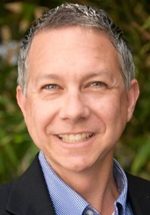 Mark E. Richards, right, served as project manager, applications engineer and systems installer for Phase Change Energy Solutions. He answered questions about the project.
Mark E. Richards, right, served as project manager, applications engineer and systems installer for Phase Change Energy Solutions. He answered questions about the project.
Q: What factors did you consider in developing a plan for PCM type, quantities and location?
A: “Available space for PCM to fit within the architectural requirements. Also the HVAC loads as well as design temperature criteria.”
Q: Describe the BioPCM products chosen for this project (peak melt points, thermal storage capacity, containment media).
A: “ENRG Blanket powered by BioPCM Q23M27 and Q23M51.”
Q: How are the BioPCM mats recharged? Using the HVAC system, nighttime air, or other means?
A: “Initially we will be using the HVAC system. The purpose of the study is to experiment and determine the most economical solution. The second floor can do a night purge more effectively since it has large air-handling unit. The first-floor systems are 2 pipe fan coils.”
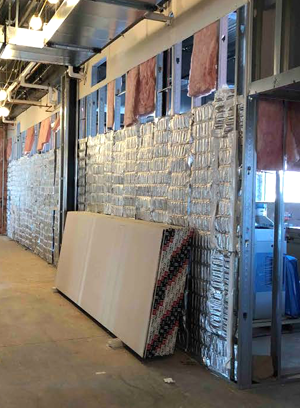 Q: Describe the equivalent (non-PCM) spaces in the control building. Were standard construction materials and techniques used in walls and ceilings?
Q: Describe the equivalent (non-PCM) spaces in the control building. Were standard construction materials and techniques used in walls and ceilings?
A: “The test spaces are of equivalent construction, use and orientation. Metal frame, with rigid and batt insulation, plaster (stucco) exterior and drywall interior. Roof is metal deck with foam on top. See CVHS BioPCM Test Rooms. These show the rooms that have all six surface temperatures monitored as a part of the thermal comfort analysis.”
Q: Describe the two types of HVAC systems used in each building.
A: “Chiller water fan coils with electric heat serve first-level zones and a single chilled water air handler with variable air volume boxes with electric resistance reheat per zone serves the second level.”
Q: What modifications are needed to typical HVAC systems used in this type of building to optimize the performance of the BioPCM products?
A: “No physical changes required. We will experiment with building management system sequence of operations to determine optimal settings.”
Q: Have you used thermal modeling to project the level of cost savings?
A: “No.”
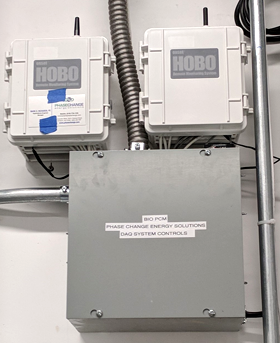 Q: How will energy savings be calculated?
Q: How will energy savings be calculated?
A: “Since we are measuring HVAC energy for the chilled water and electrical power in five-minute intervals we can monetize easily based on the local tariffs and compare the PCM building directly to the non-PCM building. We have separate HVAC power metering for each floor.“
Q: Is there anything you’d like to add about the project?
A: “DLR Group, specifically Premnath ‘Prem’ Sundharam, global sustainability leader for DLR, came up with the concept to leverage a DLR Group innovations grant funding opportunity to test BioPCM not previously been done at this scale. This pilot study, known as Thermal Mass 2.0, would not have been possible without his enthusiasm and vision. The Agua Fria Unified School District is also to be recognized for being a willing partner in this effort as well as Chasse Building Team for helping coordinate the installation of the data acquisition system (DAQ).
“The installation of DAQ system was challenging and costly. Phase Change Energy Solutions provided the BioPCM, the DAQ equipment and labor to install it significantly below cost. Dr. Reyad Sawafta, chief technology officer, and Scott Queen, VP sales, should be recognized for their commitment to proving PCM performance at this scale. We should have a pretty good idea how the two buildings compare to each other by the end of the year and look forward to analyzing the data.
“We are also studying the thermal comfort effects of BioPCM by monitoring surface temperature in two classrooms in each building of the same, type, use and occupancy. All six surfaces of each room are logged every five minutes. We monitored room temperatures during construction before the HVAC systems were active and after the PCM was installed to see how the PCM performed in a passive application. The PCM rooms were on average 2.1 F cooler than non PCM spaces pre-HVAC system operation. See chart.”
PATENTS
Battery cell including phase change material
U.S. patent application 20180254533 (applicant LG Chem Ltd., Seoul, South Korea):
“The present invention provides a battery cell of a plate shape, including: an electrode assembly in which a separator is interposed between a positive electrode and a negative electrode, wherein the electrode assembly may be mounted on a receiving part; and sealing parts formed by heat fusion at an external side of the receiving part, wherein lateral sealing parts adjacent to one of the sealing parts at which an electrode terminal is positioned may closely contact an outer surface of the receiving part while being bent toward the receiving part of a battery case, and a phase change material (PCM) that is phase-changed in response to a thermal change may be added to surplus surfaces of the lateral sealing parts or to surplus spaces between the receiving parts and the bent lateral sealing parts.”
Cooling beach blanket
U.S. patent application 20180249849 (inventor Christopher Wilkinson, Brooklyn, N.Y.):
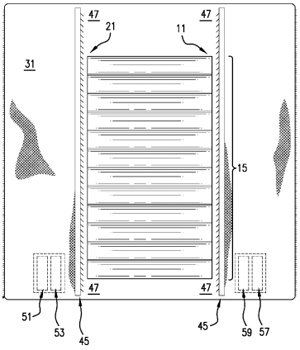 “A personal cooling system for controlling personal body temperature at the beach comprises a first layer having a first edge region defining a size and a shape of the first layer, the first layer comprising a cooling gel pack, wherein the gel pack has an outer surface and a plurality of compartments for storing a temperature-controlling ingredient therein; a second layer having a second edge region defining a size and a shape of the second layer; and an outside bag, to an inside surface of the outside bag the first layer and the second layer are attached. The second layer in the system further comprises a liquid dispenser that is embedded in the mesh material of the second layer. The actions of the cooling system and the dispenser can be controlled by a remote controller.”
“A personal cooling system for controlling personal body temperature at the beach comprises a first layer having a first edge region defining a size and a shape of the first layer, the first layer comprising a cooling gel pack, wherein the gel pack has an outer surface and a plurality of compartments for storing a temperature-controlling ingredient therein; a second layer having a second edge region defining a size and a shape of the second layer; and an outside bag, to an inside surface of the outside bag the first layer and the second layer are attached. The second layer in the system further comprises a liquid dispenser that is embedded in the mesh material of the second layer. The actions of the cooling system and the dispenser can be controlled by a remote controller.”
Insulated chamber with packetized phase change material
U.S. patent application 20180252466 (applicant Caron Products and Services Inc., Marietta, Georgia):
“An insulated chamber having an interior region for storing items therein includes a phase change material to facilitate controlling the temperature of the interior region and the items. A heating device or cooling device may be used to melt or freeze the phase change material. The phase change material (PCM) may be in various locations such as the walls of the chamber in the form of packets or in the form of containers that serve as shelves and may be removable from the interior region. The packets may have recesses for receiving the items. The phase change material may be within capsules that may be within a liquid or a solid matrix. Controls may be provided to control humidity, oxygen, and carbon dioxide within the interior chamber.”
Wall panel with phase change material
U.S. patent application 20180251986 (applicant Max Life LLC, Salisbury, N.C.):
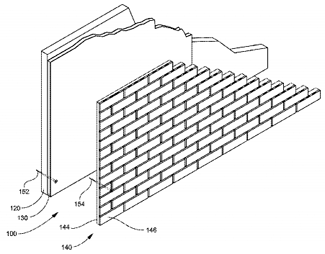 “A wall panel may have a layer made from magnesium oxide, a first insulation layer made from a two-part rigid urethane pour foam, and a second insulation layer made from a phase change material. The first insulation layer maybe chemically bonded to the magnesium oxide layer and may also be bonded to the phase change layer. The first insulation layer may be positioned between the second insulation layer and the magnesium oxide layer. The magnesium oxide layer may be a finished surface or a veneer layer may be applied to the magnesium oxide layer.”
“A wall panel may have a layer made from magnesium oxide, a first insulation layer made from a two-part rigid urethane pour foam, and a second insulation layer made from a phase change material. The first insulation layer maybe chemically bonded to the magnesium oxide layer and may also be bonded to the phase change layer. The first insulation layer may be positioned between the second insulation layer and the magnesium oxide layer. The magnesium oxide layer may be a finished surface or a veneer layer may be applied to the magnesium oxide layer.”
IN BRIEF
• The American Oil Chemists’ Society has issued a call for papers for its 2019 meeting and expo, May 5-8 in St. Louis, Mo. Topics include new technologies for oil processing; oleochemicals and green chemistry; and advanced methods of analysis, including automation. The deadline for priority consideration is Nov. 1. After that date, submissions will be considered as time and space permit.
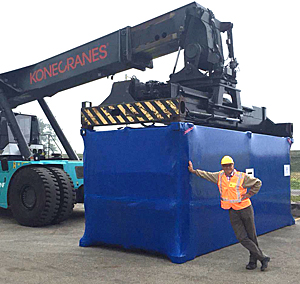 • EnergyNest announced that manufacturing of its industrial-scale thermal batteries has begun at the company’s new hub in Rotterdam. The battery, shown at right, consists of steel cassettes with pipes encased in Heatcrete, a special type of concrete developed in partnership with HeidelbergCement.
• EnergyNest announced that manufacturing of its industrial-scale thermal batteries has begun at the company’s new hub in Rotterdam. The battery, shown at right, consists of steel cassettes with pipes encased in Heatcrete, a special type of concrete developed in partnership with HeidelbergCement.
• A number of prospective postdoc researchers and their advisors are exploring the possibility of remote work, citing work/life balance and other advantages. “The setup is not without challenges,” The Scientist reports, “from simple communication difficulties to feelings of isolation, leaving postdocs to come up with bespoke solutions to their unusual situations.”
• Registration is open for the 2019 ASHRAE Winter Conference, to be held Jan. 12-16 in Atlanta. The conference’s technical program will feature more than 100 sessions and 300 speakers. Five full-day and 15 half-day seminars will be offered, including “Advanced Designs for Net Zero Buildings,” “Solar PV & Thermal System Analysis and Design” and “Thermal Energy Storage Systems for Air Conditioning.”
• Ecozen Solutions Pvt. Ltd. of Pune has won the second edition of the FedEx India Small Business Grant Contest 2018. The grant is worth about $21,000. Ecozen makes portable solar cold rooms for use on small farms. The system’s thermal storage unit can store power for more than 36 hours in case of cloudy or rainy weather.
• The Fraunhofer Institute for Solar Energy Systems ISE has developed self-learning artificial neural networks for the control of solar thermal heating systems. Fraunhofer said the savings potential, compared to an optimized conventional regulation for existing buildings, is at least 7 percent.
• Registration is open for Advancements in Thermal Management 2019, to be held Aug. 7-9 in Denver. Topics will include thermal modeling, emerging technologies, market opportunities, and thermal sensing and measurement.
• Mounting trade tensions between China and the United States have plunged global shipping markets into a continuing state of uncertainty. Peter Sand, chief shipping analyst at international shipping association Bimco, said in an interview with World Grain that the trade war could “derail the current global” upswing in shipping, the highest since 2011. The American Chemistry Council, meanwhile, released a study showing that moving forward with the latest round of tariffs would spark retaliation from China that would put nearly 55,000 jobs and around $18 billion in U.S. domestic activity at risk.
RESEARCH ROUNDUP
For our full list of recent academic research, see puretemp.com/academic. Here are highlights from the past week:
From Journal of Applied Physics:• Impact of doping on bonding energy hierarchy and melting of phase change materials
From International Communications in Heat and Mass Transfer:
• Two zone model for mushy region of solid–liquid phase change based on Lattice Boltzmann method
From Applied Sciences:
• Synthesis and Investigation of Thermal Properties of Highly Pure Carboxylic Fatty Esters to Be Used as PCM
From Solar Energy Materials and Solar Cells:
• Fabrication of novel slurry containing graphene oxide-modified microencapsulated phase change material for direct absorption solar collector
From Buildings:
• Potential of Thermal Energy Storage Using Coconut Oil for Air Temperature Control
From International Journal for Research in Engineering Application and Management:
• Development of Phase Change Material/ Cooling Plate Coupled Battery Thermal Management System Using CFD
From Applied Thermal Engineering:
• A novel graphite-PCM composite sphere with enhanced thermo-physical properties
From Journal of Cleaner Production:
• Building-integrated solar thermal system with/without phase change material: Life cycle assessment based on ReCiPe, USEtox and Ecological footprint
From Thermal Science and Engineering Progress:
• Role of metallic foam in heat storage in the presence of nanofluid and microencapsulated phase change material
From International Journal of Heat and Mass Transfer:
• Heat and flow analysis of a water droplet on hydrophobic and hydrophilic phase change material
NETWORKING
Connect with PCM experts and industry leaders on LinkedIn
 More than 1,300 people have joined a LinkedIn group devoted to the discussion of phase change material and thermal energy storage. The Phase Change Matters group is an interactive complement to the award-winning blog and newsletter of the same name.
More than 1,300 people have joined a LinkedIn group devoted to the discussion of phase change material and thermal energy storage. The Phase Change Matters group is an interactive complement to the award-winning blog and newsletter of the same name.
You are invited to join the group and connect with PCM and TES experts from around the world. This week we welcome Madjid Sarvghad, researcher at Queensland University of Technology, Brisbane, Australia; Sekar Sriramulu, founder at Fresh Brew Innovations, Chennai, India; Damon Vance, marketing director at Viking Cold Solutions Inc., Houston, Texas; and V Nagendra Kumar Pilladi, assistant manager at Azista Industries Pvt. Ltd., Hyderabad, India.